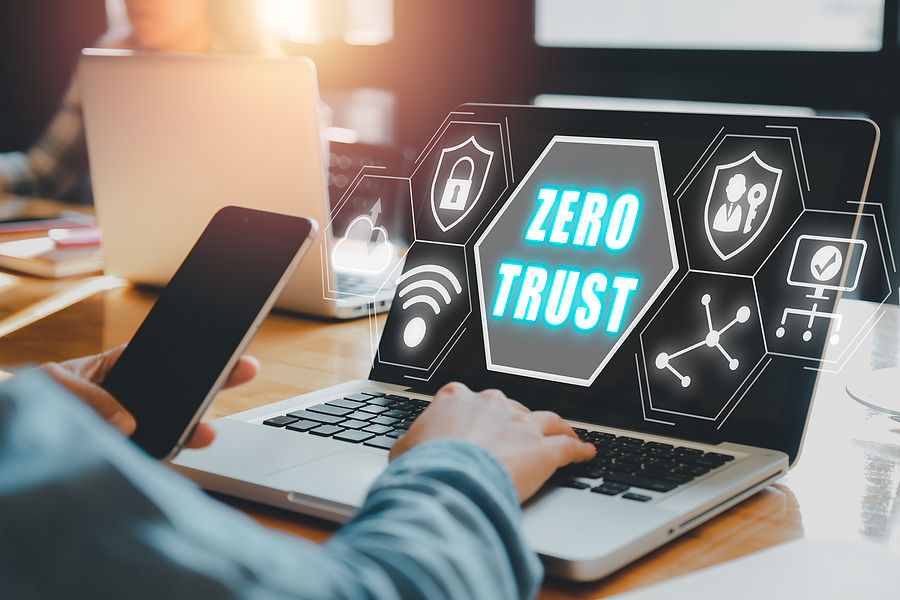
Zero trust cybersecurity is a model that assumes no person, application, or device is automatically trusted. It’s a twist on more traditional security models, which typically rely on perimeter security tools to protect networks. The result is better protection against cyberattacks.
Why Zero Trust Cybersecurity Makes Sense
The zero-trust framework follows the guiding principle that implicit trust, both inside and outside the network, is a vulnerability and that a security strategy must be built around the central belief of “never trust, always verify.”
Zero trust works on the premise that everything — people, applications and devices — poses a risk to your network and must prove trustworthy before accessing your organization’s network or data. This means every person, application, and device must be authenticated and authorized each time they request access. By insisting on verification and authentication at every step, zero trust makes it difficult for a hacker to gain access through a compromised user account or device.
Benefits of Zero Trust Cybersecurity
Implementing zero-trust cybersecurity will help you:
- Boost data protection
- Minimize attack surfaces
- Reduce the risk from growing cyberthreats
- Support adherence to compliance and insurance requirements
- Build a more secure future for your business
Considerations
Zero trust should not be mistaken for a single solution or a platform. You can’t just buy it and implement it with a click of a button. Zero trust cybersecurity is a strategy — a framework that needs to be applied systematically in your organization.
As you implement zero trust:
Continually Verify. Zero-trust is not “one and done”. You’ll need to confirm the identity and access privileges of people, devices and applications on a regular basis. Consider implementing strong identity and access controls to ensure only the right people can access the right information.
Limit Access. Misuse of privileged access is a common vulnerability that can be exploited by cybercriminals. Limiting access ensures that staff are granted minimal access without affecting their day-to-day activities. Here are some common security practices that organizations have adopted to limit access:
- Principle of Least Privilege – People, devices or applications are granted the least access or permissions needed to perform their functions. You may also put limits in place that stop staff from uploading/exporting files to the internet or external storage devices such as USB drives.
- Block by Default – People can only access applications that are explicitly approved (also known as application allowlisting). This helps prevent any malicious access to the network through an unrecognized program, installer, malware or ransomware.
- Temporary Access – People, devices or applications are granted access only for a predetermined period. This helps limit the time one has access to critical systems.
Limit Application Interactions. Another option is to control what applications can do once they’re running, including how they interact with other applications. By limiting what software can do, you can reduce the likelihood of an exploit spreading if it does breach the network.
Assume a “Breach Mentality”. Instead of waiting for a breach, operate as though the risk is already there (because it is). This will improve your response time if a breach occurs, minimize the damage, improve your overall security and, most importantly, protect your business.
Common Misconceptions
I can achieve zero trust for my business with one product. There is no single, miracle zero trust product. It takes a combination of solutions and tools to be successful.
Zero trust will be difficult for my employees and will hurt productivity and morale. As with any change, there will be a learning curve while zero trust is implemented. Still, the long-term cybersecurity benefits will outweigh any short-term inconvenience.
Implementing zero trust is complicated and expensive. While implementing zero trust will likely add costs, it’s substantially lower than your liability in the event of a major cybersecurity incident. Your IT provider can identify and implement the solutions best suited for your business and budget.
Zero-trust cybersecurity will help improve your security posture, and you don’t need to go it alone. Consult with your IT provider to help assess your needs, develop a plan for implementation, and better protect your business against cyberattacks.
If you’d like to know more about how CRU Solutions can help keep your business safer, contact us.